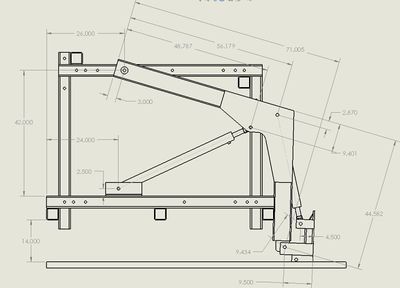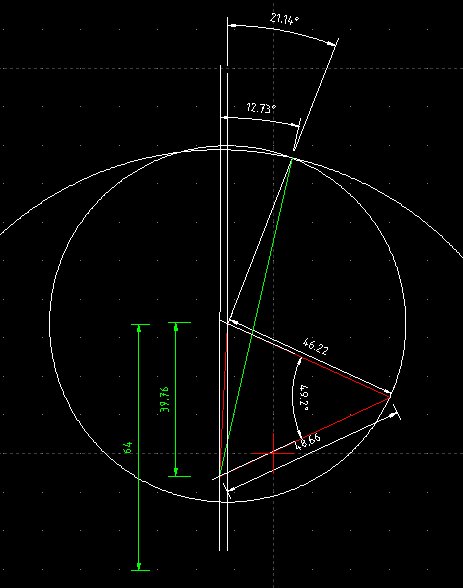LifeTrac IV Loader Lift Capacity
Introduction
This is a basic calculation of LifeTrac Prototype IV loader lifting capacity. Warning: this does not include tipping load calculations. The lifting capacity of LifeTrac is significantly greater than its tipping load capacity. Tipping loads need to be calculated.
Basic Model
The LifeTrac Prototype IV loader arm concept looks like this:
Download dxf file - units of feet - File:Loaderdrawing.dxf
Basic Analysis
From the above dxf drawing, a height reach analysis is performed to determnine the loader geometry at height. This is the analysis:
Here is the DXF file: File:LTIVheight.dxf
The red triangle models the geometry between 3 points: the cylinder to frame pin - loader to frame pivot - and loader to quick attach plate pivot.
The green line is the extended cylinder. The height of the loader arm pivot is 64 inches above the ground. The angle of the extended cylinder from the vertical is 21 degrees. The angle theta between the cylinder and the loader is 8 degrees in the fully extended position, and the angle theta prime is 49 degrees in the retracted position. The angle phi off vertical of the extended loader arms is about 21 degrees.
Cylinder specification - see [1] : 2.5" diameter, 2500 psi, 36" stroke.
Torque balance calculations indicate over 12,000 lb of lifting force at the fully retracted position, and approximately 2000 lb at full height.
Torque Balance Calculations
Extended Position
Downward torque at cylinder-arm attachment is (assuming all loader weight is approximately at the end of the loader arms, and assuming cylinder attachment is approximately at the half way point on the arms):
F_c = force of cylinder = pi r^2 * Pressure = 12,500 lb Pressure = 2500 psi r=1.25" Force of 2 cylinders (25,000 lb)
M=mass of loader=2000lb
Torque balance around pivot:
Down:
2M*sin(phi)=4000*sin(21 deg) = 1400lb
Up:
2*F_c*sin(theta) = 25,000*sin(8 deg) = 3500 lb
The difference between up and down forces indicates a static lifting capacity of 2000 lb at full height.
Retracted Position
Going through similar analysis except with theta prime = 49 degrees - impressive lifting capacity is shown with at least 12,000 lb of lifting power. This means that the tractor will tip forward readily when it tries to pick up objects beyond its tipping point.
Needs
Full tipping load anaylysis needs to be pulled out of the CAD model once it is complete from Mike Apostol.

